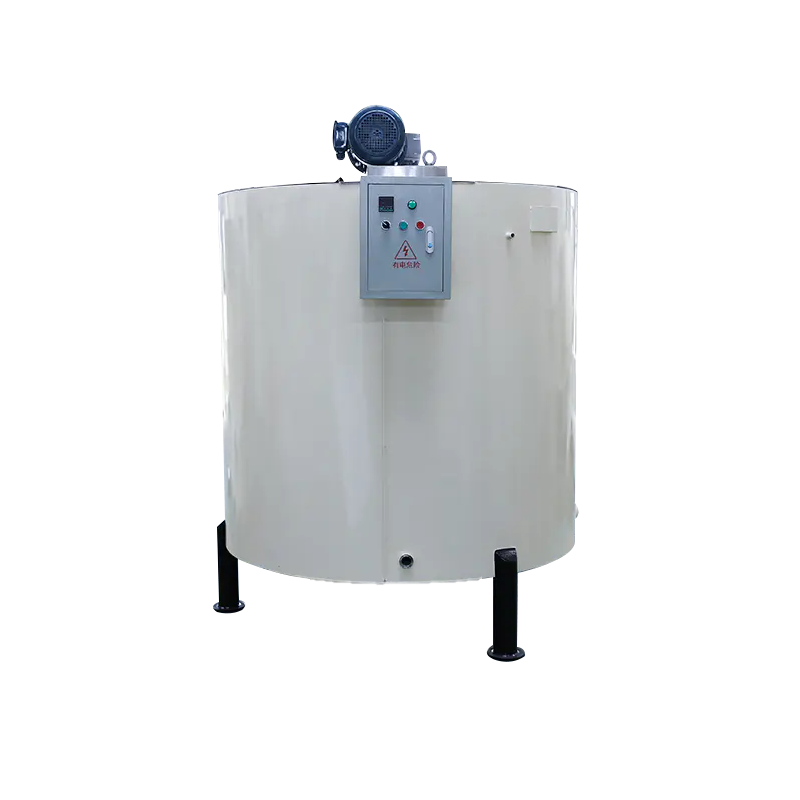The thermal management system of the chocolate insulation tank, with its innovative double-layer jacket structural design and dynamic control strategy of the heat transfer medium, builds a precise defense line against temperature fluctuations, ensuring the stability of the cocoa butter crystal morphology and controllable chocolate rheological properties, laying a quality foundation for subsequent molding processes. Cocoa butter, the core ingredient of chocolate, exists in a variety of crystal forms. Slight changes in temperature can trigger a crystal transformation, which in turn significantly affects the physical properties of chocolate. When the temperature rises, the cocoa butter crystal structure softens, causing the chocolate viscosity to decrease and the fluidity to increase. In severe cases, oil separation occurs. A sudden drop in temperature prompts the rapid formation of unstable crystals, causing a surge in viscosity, resulting in pipe blockages and pumping difficulties. These changes not only destroy the uniformity of the chocolate's texture, but also cause defects such as surface atomization and brittle cracking during the molding process. Therefore, accurately controlling the temperature of chocolate within the strict range of ±1°C has become the core mission of the thermal management system of the insulation tank. As the physical cornerstone of the thermal management system, the double-layer jacket structure achieves the dual functions of efficient heat conduction and thermal insulation through innovative design. The insulation tank is constructed with the tank body as the center, with inner and outer cavities, and heat transfer media such as hot water or hot oil circulates in the interlayer space. The outer jacket fits tightly with high-efficiency thermal insulation materials such as polyurethane foam or rock wool to form an insulation barrier, which greatly reduces the heat exchange between the tank and the external environment; the inner jacket is made of stainless steel with excellent thermal conductivity. Its smooth mirror-polished inner surface reduces material adhesion while effectively reducing thermal resistance, ensuring that heat is quickly transferred to the chocolate in the tank. The flow channel design of the jacket follows the principles of fluid mechanics. By rationally arranging the medium inlet and outlet and guide plates, the heat-conducting medium forms a uniform and stable flow path in the interlayer, avoiding local temperature deviation and achieving uniform heating of the chocolate in the tank. The dynamic control system of the heat transfer medium gives the thermal management system adaptive capabilities. The system uses high-precision temperature sensors as sensing units to monitor the temperature of chocolate at different locations in the tank in real time and feed the data back to the central control unit. The control unit is like the "brain" of the thermal management system. It intelligently adjusts the flow, temperature and circulation speed of the heat transfer medium according to the preset process temperature parameters. When it is detected that the temperature inside the tank is lower than the set value, the system immediately increases the heating power of the heat transfer medium and speeds up the circulation flow rate to quickly transfer heat to the material; if the temperature is too high, the medium temperature is lowered and the flow rate is slowed down to prevent the chocolate from overheating. This closed-loop feedback mechanism ensures that the temperature fluctuation of the insulation tank can be controlled to the minimum range under dynamic conditions such as changes in the external environment and material in and out. The precise control of the thermal management system is deeply integrated with the requirements of chocolate production process. Different types of chocolate have different requirements for storage temperature due to different recipes: dark chocolate usually needs to be maintained at 30-32℃, while milk chocolate is best stored at 27-29℃. The thermal management system of the insulation tank can quickly switch the temperature control mode of chocolate with different recipes by presetting multiple sets of temperature curves. In continuous production scenarios, when multiple insulation tanks are used in series, the thermal management system can also achieve temperature gradient control to meet the temperature requirements of multiple links such as chocolate tempering, storage, and transportation. For example, the tempered chocolate needs to be left standing at a specific temperature to stabilize its crystal shape. The insulation tank ensures the integrity of the crystal structure through precise temperature control, providing quality assurance for the subsequent molding process. In addition, the thermal management system is designed to balance energy efficiency and ease of operation. Unnecessary heat loss can be reduced by optimizing the circulation path and heat exchange efficiency of the heat transfer medium; the intelligent control system supports remote monitoring and parameter adjustment, so that operators can understand the temperature status inside the tank in real time and flexibly adjust the temperature control strategy according to production needs. The thermal management system of the chocolate insulation tank minimizes the impact of temperature fluctuations on chocolate quality through structural innovation of the double-layer jacket and dynamic regulation of the heat transfer medium. This sophisticated thermal management solution maintains the physical properties and chemical stability of liquid chocolate.


 中文简体
中文简体 English
English Français
Français عربى
عربى


